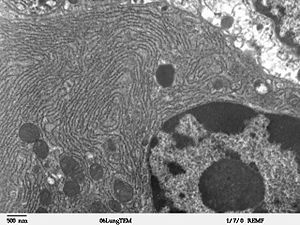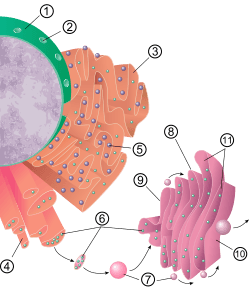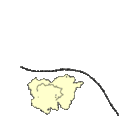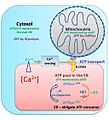Endoplasmic reticulum facts for kids


Endoplasmic reticulum (ER) is a cellular organelle. It is the transport network for molecules going to specific places, as compared to molecules that float freely in the cytoplasm. The endoplasmic reticulum is in cells that have a nucleus: in eukaryote cells but not in prokaryote cells. It takes these forms:
- Rough endoplasmic reticulum (RER), so called because it is studded with ribosomes, and secretes proteins into the cytoplasm.
- Smooth endoplasmic reticulum (SER). Among its functions is the production of proteins and steroids, the maintenance of plasma membranes, and a pathway for molecules to move along.
Similar to the ER is the sarcoplasmic reticulum (SR) found only in muscle cells. The SR stores and pumps calcium ions. The SR contains large stores of calcium, which it releases when the muscle cell is stimulated. Another type of cytoplasmic network is the plate-like Golgi apparatus.
The lacey membranes of the endoplasmic reticulum were first seen in 1945 by scientists using an electron microscope.
Images for kids
-
A 2-minute animation showing how a protein destined for the secretory pathway is synthesized and secreted into the rough endoplasmic reticulum, which appears at the upper right approximately halfway through the animation.
See also
 In Spanish: Retículo endoplasmático para niños
In Spanish: Retículo endoplasmático para niños





